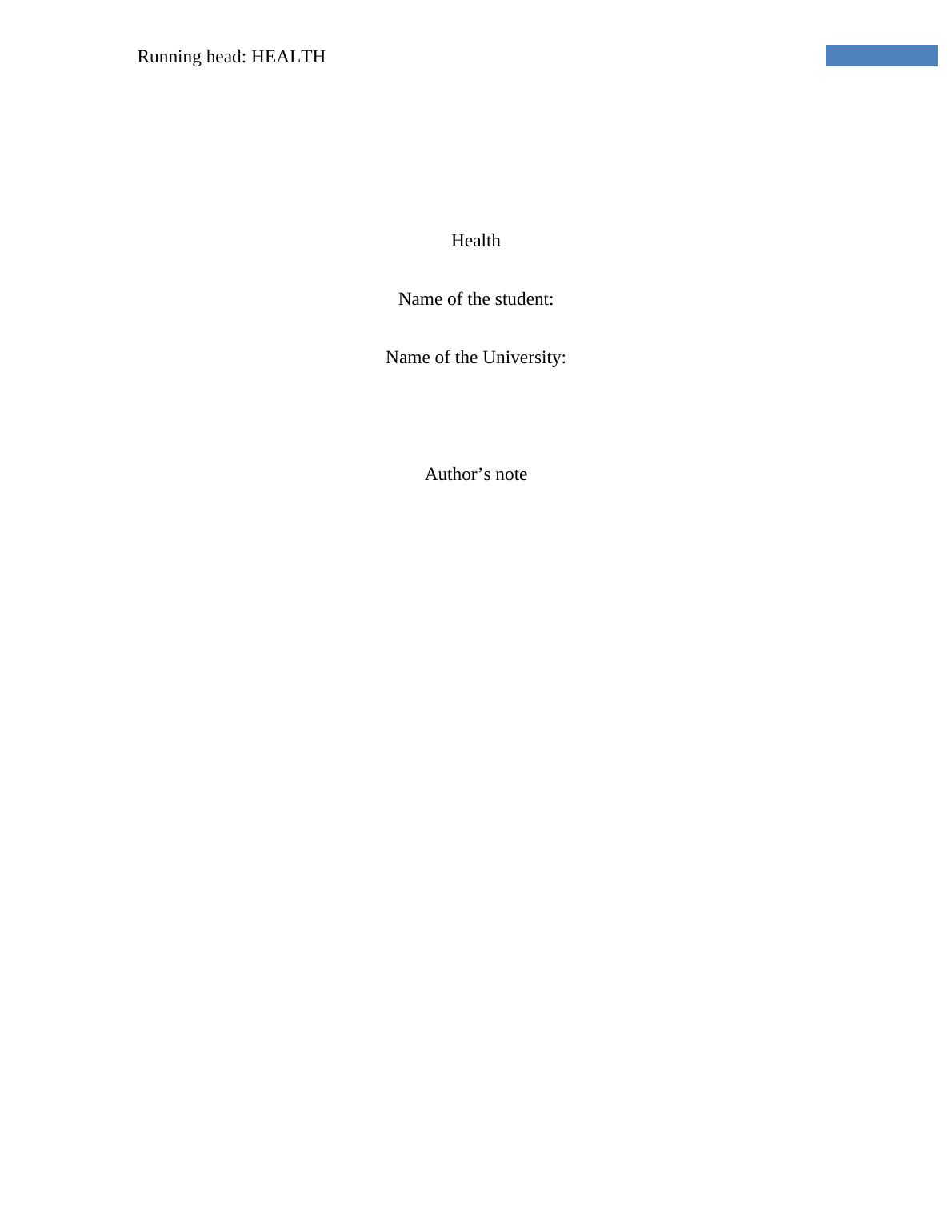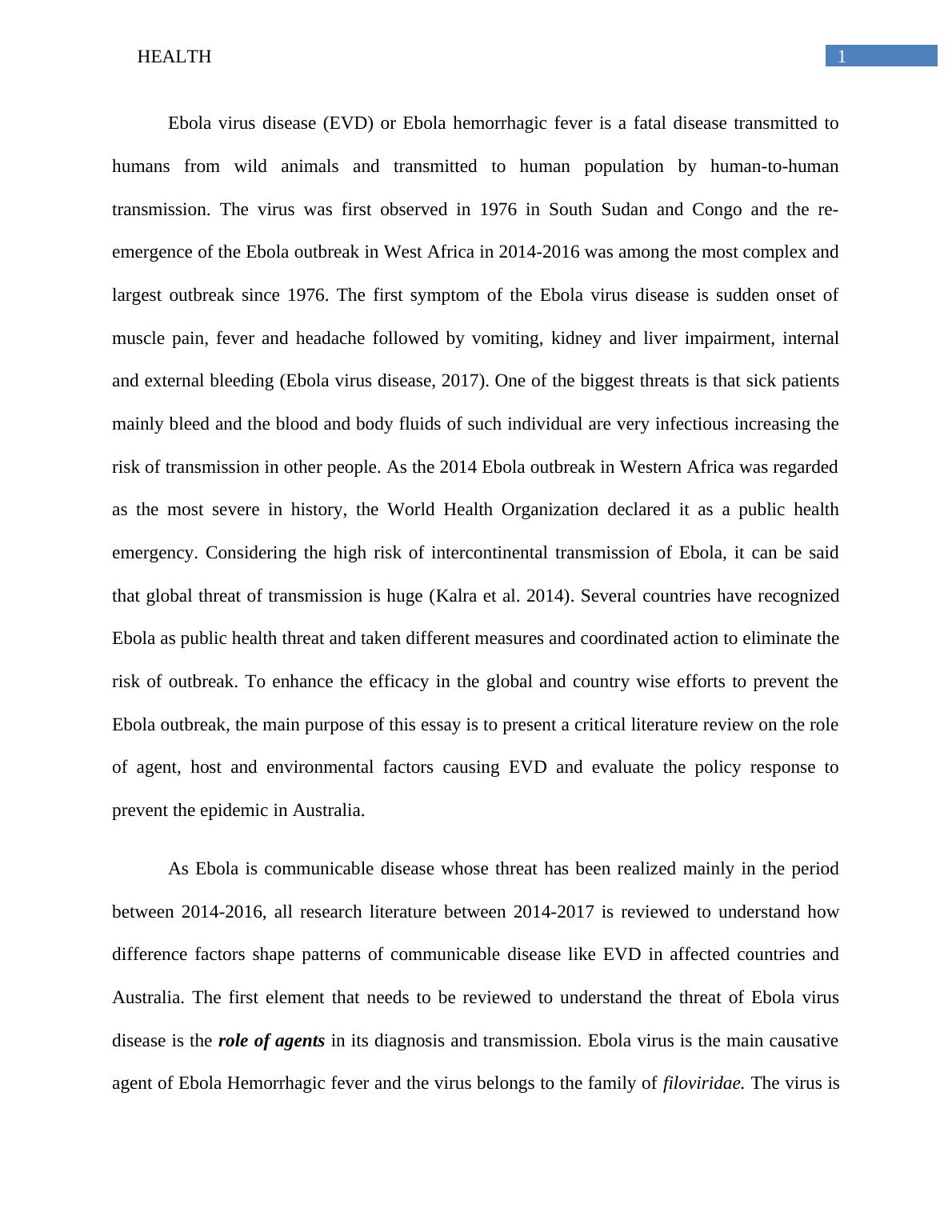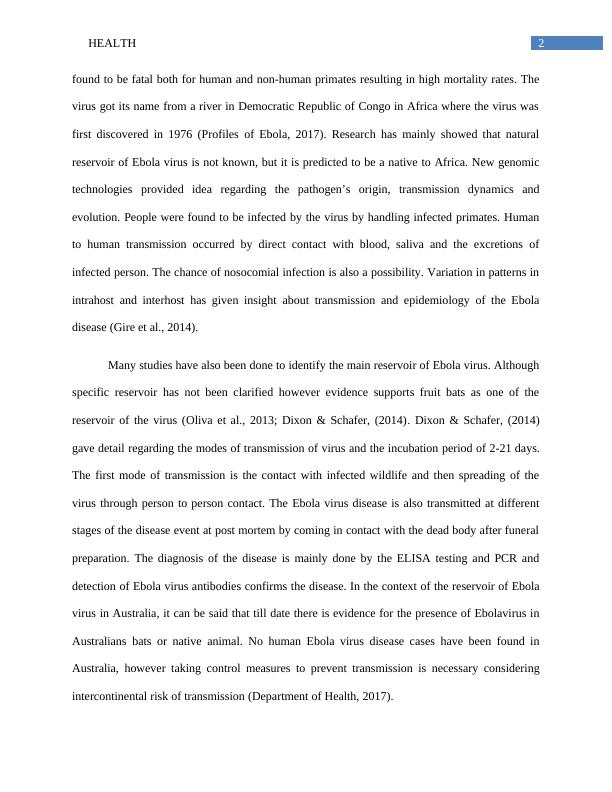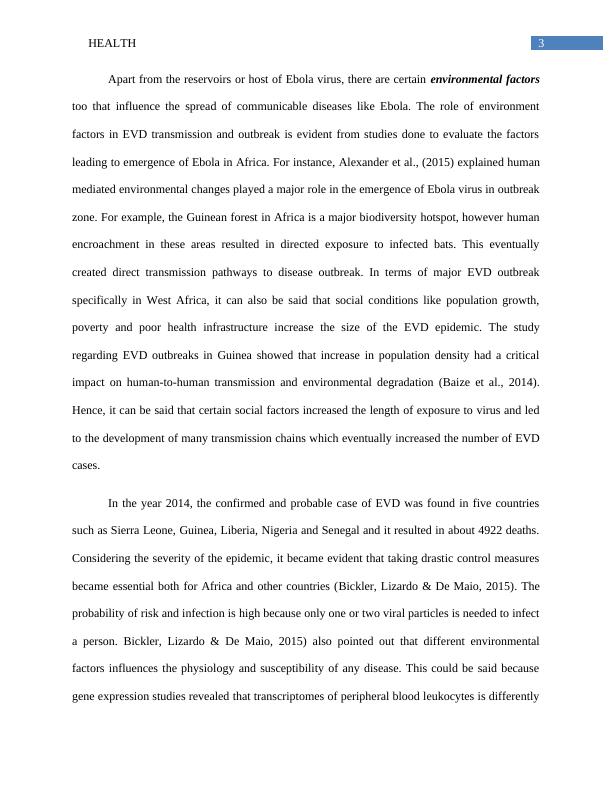Essay on Ebola Outbreak Prevention
14 Pages4066 Words199 Views
Western Sydney University
Added on 2020-05-04
Essay on Ebola Outbreak Prevention
Western Sydney University
Added on 2020-05-04
ShareRelated Documents
Running head: HEALTHHealthName of the student:Name of the University:Author’s note

1HEALTHEbola virus disease (EVD) or Ebola hemorrhagic fever is a fatal disease transmitted tohumans from wild animals and transmitted to human population by human-to-humantransmission. The virus was first observed in 1976 in South Sudan and Congo and the re-emergence of the Ebola outbreak in West Africa in 2014-2016 was among the most complex andlargest outbreak since 1976. The first symptom of the Ebola virus disease is sudden onset ofmuscle pain, fever and headache followed by vomiting, kidney and liver impairment, internaland external bleeding (Ebola virus disease, 2017).One of the biggest threats is that sick patientsmainly bleed and the blood and body fluids of such individual are very infectious increasing therisk of transmission in other people. As the 2014 Ebola outbreak in Western Africa was regardedas the most severe in history, the World Health Organization declared it as a public healthemergency. Considering the high risk of intercontinental transmission of Ebola, it can be saidthat global threat of transmission is huge (Kalra et al. 2014). Several countries have recognizedEbola as public health threat and taken different measures and coordinated action to eliminate therisk of outbreak. To enhance the efficacy in the global and country wise efforts to prevent theEbola outbreak, the main purpose of this essay is to present a critical literature review on the roleof agent, host and environmental factors causing EVD and evaluate the policy response toprevent the epidemic in Australia. As Ebola is communicable disease whose threat has been realized mainly in the periodbetween 2014-2016, all research literature between 2014-2017 is reviewed to understand howdifference factors shape patterns of communicable disease like EVD in affected countries andAustralia. The first element that needs to be reviewed to understand the threat of Ebola virusdisease is the role of agents in its diagnosis and transmission. Ebola virus is the main causativeagent of Ebola Hemorrhagic fever and the virus belongs to the family of filoviridae. The virus is

2HEALTHfound to be fatal both for human and non-human primates resulting in high mortality rates. Thevirus got its name from a river in Democratic Republic of Congo in Africa where the virus wasfirst discovered in 1976 (Profiles of Ebola, 2017). Research has mainly showed that naturalreservoir of Ebola virus is not known, but it is predicted to be a native to Africa. New genomictechnologies provided idea regarding the pathogen’s origin, transmission dynamics andevolution. People were found to be infected by the virus by handling infected primates. Humanto human transmission occurred by direct contact with blood, saliva and the excretions ofinfected person. The chance of nosocomial infection is also a possibility. Variation in patterns inintrahost and interhost has given insight about transmission and epidemiology of the Eboladisease (Gire et al., 2014). Many studies have also been done to identify the main reservoir of Ebola virus. Althoughspecific reservoir has not been clarified however evidence supports fruit bats as one of thereservoir of the virus (Oliva et al., 2013; Dixon & Schafer, (2014). Dixon & Schafer, (2014)gave detail regarding the modes of transmission of virus and the incubation period of 2-21 days.The first mode of transmission is the contact with infected wildlife and then spreading of thevirus through person to person contact. The Ebola virus disease is also transmitted at differentstages of the disease event at post mortem by coming in contact with the dead body after funeralpreparation. The diagnosis of the disease is mainly done by the ELISA testing and PCR anddetection of Ebola virus antibodies confirms the disease. In the context of the reservoir of Ebolavirus in Australia, it can be said that till date there is evidence for the presence of Ebolavirus inAustralians bats or native animal. No human Ebola virus disease cases have been found inAustralia, however taking control measures to prevent transmission is necessary consideringintercontinental risk of transmission (Department of Health, 2017).

3HEALTHApart from the reservoirs or host of Ebola virus, there are certain environmental factorstoo that influence the spread of communicable diseases like Ebola. The role of environmentfactors in EVD transmission and outbreak is evident from studies done to evaluate the factorsleading to emergence of Ebola in Africa. For instance, Alexander et al., (2015) explained humanmediated environmental changes played a major role in the emergence of Ebola virus in outbreakzone. For example, the Guinean forest in Africa is a major biodiversity hotspot, however humanencroachment in these areas resulted in directed exposure to infected bats. This eventuallycreated direct transmission pathways to disease outbreak. In terms of major EVD outbreakspecifically in West Africa, it can also be said that social conditions like population growth,poverty and poor health infrastructure increase the size of the EVD epidemic. The studyregarding EVD outbreaks in Guinea showed that increase in population density had a criticalimpact on human-to-human transmission and environmental degradation (Baize et al., 2014).Hence, it can be said that certain social factors increased the length of exposure to virus and ledto the development of many transmission chains which eventually increased the number of EVDcases. In the year 2014, the confirmed and probable case of EVD was found in five countriessuch as Sierra Leone, Guinea, Liberia, Nigeria and Senegal and it resulted in about 4922 deaths.Considering the severity of the epidemic, it became evident that taking drastic control measuresbecame essential both for Africa and other countries (Bickler, Lizardo & De Maio, 2015). Theprobability of risk and infection is high because only one or two viral particles is needed to infecta person. Bickler, Lizardo & De Maio, 2015) also pointed out that different environmentalfactors influences the physiology and susceptibility of any disease. This could be said becausegene expression studies revealed that transcriptomes of peripheral blood leukocytes is differently

End of preview
Want to access all the pages? Upload your documents or become a member.
Related Documents
Globalization and Impact on Health Assignment PDFlg...
|9
|3007
|72
Globalization and Public Health Management of Ebolalg...
|7
|2559
|344
A Review of Ebora Viral Diseaselg...
|17
|4908
|36
PUBH6006: Community Health And Disease Preventionlg...
|9
|2347
|71
Impact of globalisation on healthlg...
|12
|3440
|195
Ebola Virus Disease: Causes, Symptoms, and Environmental Factorslg...
|14
|4463
|473
